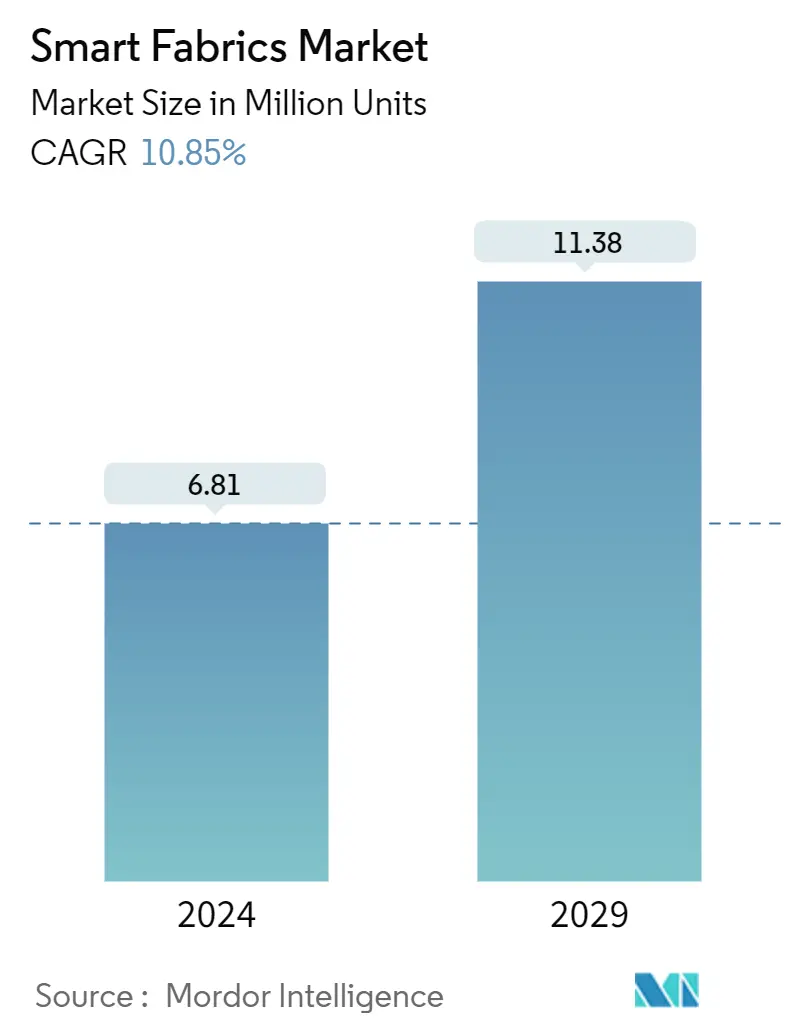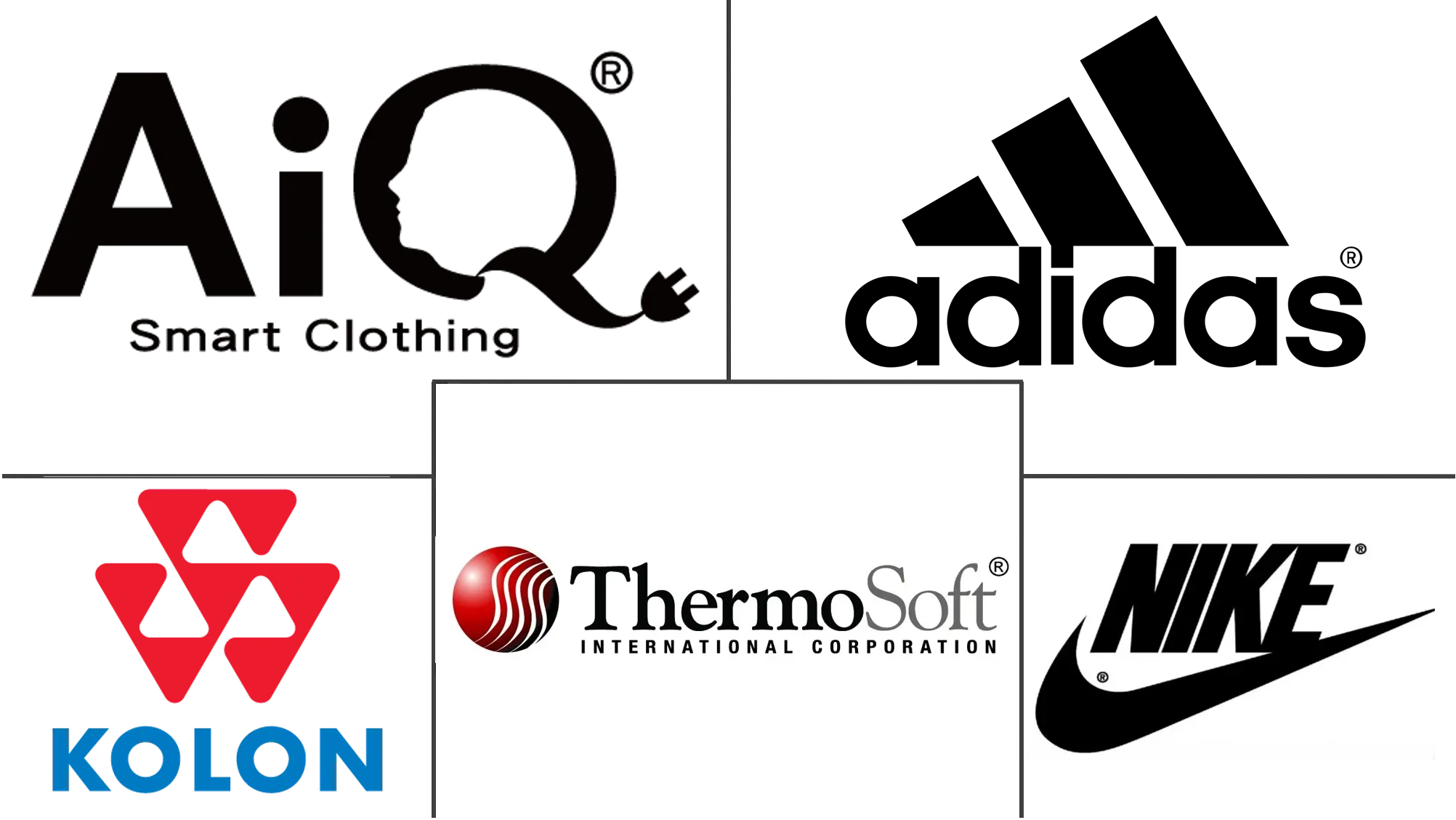
| Study Period | 2019-2029 |
| Market Volume (2024) | 6.81 Million units |
| Market Volume (2029) | 11.38 Million units |
| CAGR (2024 - 2029) | 10.85 % |
| Fastest Growing Market | Asia Pacific |
| Largest Market | North America |
| Market Concentration | Low |
Major Players
*Disclaimer: Major Players sorted in no particular order |
Smart Fabrics Market Analysis
The Smart Fabrics Market size is estimated at 6.81 Million units in 2024, and is expected to reach 11.38 Million units by 2029, growing at a CAGR of 10.85% during the forecast period (2024-2029).
Smart textiles are fabrics that are manufactured and designed to integrate technologies that offer the user increased functionality. R&D toward wearable textile-based personal systems, such as health monitoring, protection and safety, and healthy lifestyles, gained major interest over the last few years. Recently, MIT developed smart clothing that follows the most important indicators of human health, i.e., heart rate, respiratory rate, and temperature. This was achieved by sewing into the fabric of sensitive sensors that fit the skin.
- The growth in the wearable electronics industry is driving the market. The growing demand for smart wearables across various end-user industries is the major factor driving the growth of the smart fabric market. A significant amount of effort is witnessed to expand what fabric wearables can do with respect to payments. Mastercard partnered with Timex to integrate contactless payments into their watches, while a U.K.-based CashCuff did the same with the cufflinks. When such distinguished applications become mainstream, which it has, the market is very likely to shift to accommodate similar trends in smart fabrics.
- Miniaturization of electronics and developments across flexible electronics is driving the market. The efficiency of smart fabrics is enhancing with the advancement in miniaturized electronic items, such as sensors, actuators (for active smart textiles), and controlling units (advanced smart textiles). Significant expertise in multifunctional plastics manufacturing, nanoscale manufacturing, and printed electronics has been seen. For instance, UMass Lowell develops flexible electronics and smart textiles-some ongoing research projects. We are developing high-frequency printed conformal antennas, carbon-based transistors, and photonic devices and researching wearable antennas for the military.
- Further, the developments on wearable triboelectric nanogenerators in shapes of fiber, yarn, and textile enable a signficant development in the market studied. These nanogenerators, when effectively integrated with devices such as supercapacitor, lithium battery, and solar cell, their feasibility for realizing self-charging wearable systems have been proven to attract the attention of smart wearables.
- For instance, Nextiles, a textile manufacturing firm, recently entered the sports and performance industry with smart thread technology that records physiological and biomechanical data. The flexible cloth used in everyday sportswear was created by Nextiles by fusing conventional stitching methods with printed circuit boards. Nextiles' fabrics enable biomechanic and biometric sensing recorded on one platform owing to the patented production technique.
- Further, with the outbreak of COVID-19, the market did not experience substantial growth. This is because manufacturing smart fabric needed a high degree of automation and advancements in textile processing techniques such as electronic controlling system, computer-aided design, automated inspection, etc. The industry did not come under the essential services segment as it was considered in the 'apparel and lifestyle goods' category, resulting from which factories were currently not under operations.
Smart Fabrics Industry Segmentation
Smart fabrics are fibrous structures capable of sensing, actuating, generating/storing power, and/or communicating. The study highlights various stakeholders who are involved in the manufacturing of the smart fabric and the components involved, such as actuator materials, conductive materials, sensor materials, and electronics and providing solutions across various applications such as Fashion and Entertainment, Sports and Fitness, Medical and Healthcare, Transportation, and others.
The smart fabrics market is segmented by type (passive smart fabrics, active fabrics, ultra-smart fabrics), application (fashion and entertainment, sports and fitness, medical, transportation and others, space and military, industrial), and geography (North America, Europe, Asia-Pacific, Latin America, Middle-East and Africa) .The market sizes and forecasts are provided in terms of value (USD) for all the above segments.
| Passive Smart Fabrics |
| Active Fabrics |
| Ultra-smart Fabrics |
| Fashion and Entertainment |
| Sports and Fitness |
| Medical |
| Transportation and Others |
| Space and Military |
| Industrial |
| North America |
| Asia Pacific |
| Europe |
| Rest of the World |
Smart Fabrics Market Size Summary
The smart fabrics market is experiencing significant growth, driven by advancements in wearable electronics and flexible electronics. Smart textiles, designed to integrate technology for enhanced functionality, are gaining traction across various industries, including fashion, healthcare, and military applications. The market is characterized by innovations such as MIT's development of smart clothing that monitors vital health indicators and the integration of contactless payment systems in wearable devices. The miniaturization of electronics, including sensors and actuators, is further propelling the market, with companies like UMass Lowell and Nextiles leading research and development efforts. The fashion industry is also a key player, with brands like Uniqlo, Lululemon, and Tommy Hilfiger incorporating smart fabrics to create aesthetically pleasing and technologically advanced garments.
North America is poised to hold a significant share of the smart fabrics market, with the United States leading in the adoption of connected wearable products. The region is witnessing extensive research and development aimed at creating adaptive thermal clothing and other innovative smart fabric solutions. Notable developments include MIT's smart fabrics that adapt to body movements and temperature-responsive textiles from Aalto University. The market is fragmented, with numerous vendors and startups like Xenoma and Loomia Technologies competing for market share. Recent collaborations and product launches, such as Schoeller Textil AG's sustainable collection and Loomia's heated handwear, highlight the dynamic nature of the industry. As smart fabrics continue to evolve, they are expected to offer new opportunities for enhancing human comfort, health, and well-being.
Smart Fabrics Market Size - Table of Contents
1. MARKET DYNAMICS
- 1.1 Market Overview
-
1.2 Industry Attractiveness - Porter's Five Forces Analysis
- 1.2.1 Bargaining Power of Suppliers
- 1.2.2 Bargaining Power of Consumers
- 1.2.3 Threat of New Entrants
- 1.2.4 Intensity of Competitive Rivalry
- 1.2.5 Threat of Substitute Products
- 1.3 Industry Value Chain Analysis
- 1.4 Assessment of Impact of COVID-19 on the Industry
2. MARKET DYNAMICS
-
2.1 Market Drivers
- 2.1.1 Growth in Wearable Electronics Industry
- 2.1.2 Miniaturization of Electronics and Developments across Flexible Electronics
-
2.2 Market Challenges
- 2.2.1 High Cost and Data Security Concerns
3. MARKET SEGMENTATION
-
3.1 Type
- 3.1.1 Passive Smart Fabrics
- 3.1.2 Active Fabrics
- 3.1.3 Ultra-smart Fabrics
-
3.2 Application
- 3.2.1 Fashion and Entertainment
- 3.2.2 Sports and Fitness
- 3.2.3 Medical
- 3.2.4 Transportation and Others
- 3.2.5 Space and Military
- 3.2.6 Industrial
-
3.3 Geography
- 3.3.1 North America
- 3.3.2 Asia Pacific
- 3.3.3 Europe
- 3.3.4 Rest of the World
Smart Fabrics Market Research FAQs
How big is the Smart Fabrics Market?
The Smart Fabrics Market size is expected to reach 6.81 million units in 2024 and grow at a CAGR of 10.85% to reach 11.38 million units by 2029.
What is the current Smart Fabrics Market size?
In 2024, the Smart Fabrics Market size is expected to reach 6.81 million units.


